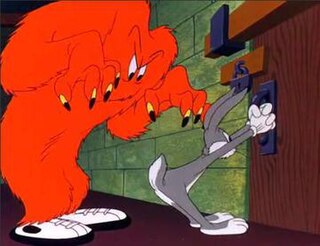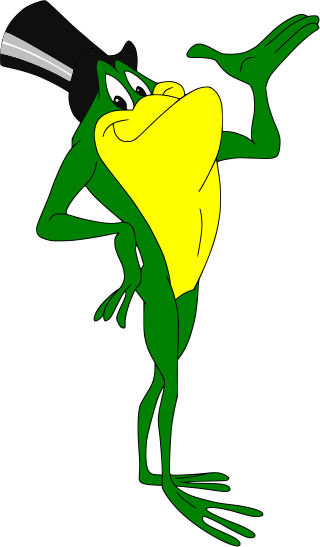Related Research Articles

Porky Pig is an animated character in the Warner Bros. Looney Tunes and Merrie Melodies series of cartoons. He was the first character created by the studio to draw audiences based on his star power, and the animators created many critically acclaimed shorts featuring the character. Even after he was supplanted by later characters, Porky continued to be popular with moviegoers and, more importantly, the Warners directors, who recast him in numerous everyman and sidekick roles.

Gossamer is an animated character in the Warner Bros. Looney Tunes and Merrie Melodies series of cartoons. He is a large, hairy, orange or red monster. His body is perched on two giant tennis shoes, and his heart-shaped face is composed of only two oval eyes and a wide mouth, with two hulking arms ending in dirty, clawed fingers. The monster's main trait is his uncombed, orange hair. He originally was voiced by Mel Blanc and has been voiced by Frank Welker, Maurice LaMarche, Joe Alaskey, Jim Cummings, Kwesi Boakye, Eric Bauza and currently Fred Tatasciore.

Michigan Jackson Frog is an animated cartoon character from the Warner Bros.' Merrie Melodies film series. Originally a one-shot character, his only appearance during the original run of the Merrie Melodies series was as the star of the One Froggy Evening short film, written by Michael Maltese and directed by Chuck Jones. In this cartoon, partly inspired by a 1944 Cary Grant film entitled Once Upon a Time, Michigan is a male frog who wears a top hat; carries a cane; and sings pop music, ragtime, Tin Pan Alley hits, and other songs from the late 19th and early 20th centuries while dancing and performing acrobatics in the style of early 20th century vaudeville. Michigan is discovered by a hapless construction worker who plans to profit off his talents but catches on too late that the frog performs exclusively for his owner, and behaves like an ordinary frog in front of anyone else. When he does perform, he finishes each song before the man can showcase his talent, thus thwarting his dreams of wealth.
Buddy the Gob is a 1934 Warner Bros. Looney Tunes cartoon, the first directed by Friz Freleng. The short was released on January 5, 1934, and stars Buddy, the second star of the series.

Bugs Bunny Gets the Boid is a 1942 Merrie Melodies cartoon, directed by Bob Clampett, produced by Leon Schlesinger, and released to theatres by Warner Bros. Pictures. It marks the first appearance of Beaky Buzzard in a Warner Bros. short.

Water, Water Every Hare is a 1952 Warner Bros. Looney Tunes cartoon directed by Chuck Jones. The cartoon was released on April 19, 1952 and stars Bugs Bunny. The short is a return to the themes of the 1946 cartoon Hair-Raising Hare and brings the monster Gossamer back to the screen.

The Looney Looney Looney Bugs Bunny Movie is a 1981 American animated comedy package film with a compilation of classic Looney Tunes/Merrie Melodies Warner Bros. cartoon shorts and animated bridging sequences produced and directed by Friz Freleng, hosted by Bugs Bunny. The new footage was produced by Warner Bros. Animation. It was the first Looney Tunes/Merrie Melodies film with a compilation of classic cartoon comedy shorts produced by Warner Bros. Animation.

Elmer J. Fudd is an animated cartoon character in the Warner Bros. Looney Tunes/Merrie Melodies series and the archenemy of Bugs Bunny. His aim is to hunt Bugs, but he usually ends up seriously injuring himself and other antagonizing characters. He speaks in an unusual way, replacing his Rs and Ls with Ws, so he often refers to Bugs Bunny as a "scwewy" or "wascawwy (rascally) wabbit". Elmer's signature catchphrase is, "Shhh. Be vewy vewy quiet, I'm hunting wabbits", as well as his trademark laughter.
Buddy's Trolley Troubles is an American animated short film. It is a Looney Tunes cartoon, featuring Buddy, the second star of the series. It was released on May 5, 1934 and is the third cartoon supervised by Friz Freleng. Musical direction was by Norman Spencer.
Buddy's Garage is a 1934 Warner Bros. Looney Tunes cartoon, the last to be directed by Earl Duvall. The short was released on April 14, 1934, and stars Buddy, the second star of the series.
Buddy's Bearcats is a 1934 Warner Bros. Looney Tunes cartoon, directed by Jack King. The short was released on June 23, 1934, and stars Buddy, the second star of the series.
Buddy the Detective is a 1934 Warner Bros. Looney Tunes cartoon, directed by Jack King. The short was released on October 17, 1934, and stars Buddy, the second star of the series.
Viva Buddy is a 1934 Warner Bros. Looney Tunes cartoon directed by Jack King. The short was released on December 12, 1934, and stars Buddy, the second star of the series.
Buddy's Adventures is a 1934 Warner Bros. Looney Tunes cartoon, directed by Ben Hardaway. The short was released on November 17, 1934, and stars Buddy, the second star of the series.
Buddy's Pony Express is a 1935 Warner Bros. Looney Tunes cartoon, directed by Ben Hardaway. The short was released on March 9, 1935, and stars Buddy, the second star of the series.
Buddy of the Legion is an American animated short film, released April 6, 1935. It is a Looney Tunes cartoon, featuring Buddy, the second star of the series. It was directed by Ben Hardaway; Bernard Brown was musical director.
Buddy in Africa is an American animated short film, released by Warner Bros. under the Looney Tunes series on July 6, 1935. It stars Buddy, the second star of the series. Ben Hardaway supervised the short; musical direction was by Norman Spencer. Notably, Jack Carr, who provided Buddy's voice, is a credited animator on this cartoon. The short Buddy in Africa was first shown at the Whittier Theatre in Whittier, California on its release day.
Buddy Steps Out is an American animated short film, released by Warner Bros. on July 20, 1935. It is a Looney Tunes cartoon, featuring Buddy, the second star of the series. It was supervised by Jack King, and musical direction was by Bernard Brown. Notably, Chuck Jones and Bob Clampett are credited animators for the short.
Buddy the Gee Man is a 1935 Warner Bros. Looney Tunes cartoon, directed by Jack King. The short was released on August 24, 1935, and stars Buddy, the second star of the series.
References
- ↑ Scott, Keith (2022). Cartoon Voices from the Golden Age, 1930-70. BearManor Media. p. 15. ISBN 979-8-88771-010-5.
- ↑ Maltin, Leonard. Of Mice and Magic: a History of American Animated Cartoons. Von Hoffmann Press, Inc., 1980. p. 406
- ↑ Beck, Jerry; Friedwald, Will (1989). Looney Tunes and Merrie Melodies: A Complete Illustrated Guide to the Warner Bros. Cartoons. Henry Holt and Co. p. 37. ISBN 0-8050-0894-2.